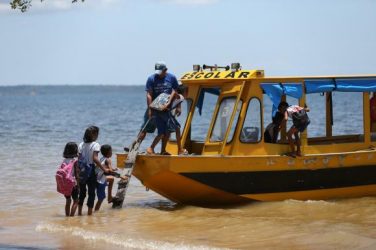The Amazon, perhaps more than any other region of the globe, has consistently been idealized and mythologised. This is true both of its societies, often envisioned as ‘lost tribes in the forest’, and the ‘raw green hell’ of its environment.
Although it has been incorporated into the modern world system since the 16th century, Amazonia is still widely regarded as a lush, beckoning frontier of untapped natural resources.
This matters because stereotypical images effect how the region continues to be treated in terms of international politics, commercial ventures, environmentalist interventions and developmental prescriptions.
The modern reassertion of Amazonia as untapped nature, also currently wrapped in a globalist eco-package – lungs of the Earth, bio-diversity, carbon sink – offers license for rapacious commercial exploitation.
One of the implications of the ‘frontier still to be conquered’ is that Amazonia offers the comparative advantage of ‘cheap nature’ and is not seen as a social landscape. This is an idea that is captured in the subtitle of the archaeologist Betty Meggar’s influential book Amazonia: Man and Culture in a Counterfeit Paradise.
This process of erasing the idea of a social landscape proceeds in part by denying the viability, or indeed history, of the numerous social landscapes of Amazonia, past and present.
We’re seeing the building of highly destructive roads and hydroelectric dam programs, such as those currently pursued in the Tapajós and Xingu basins. The region is also currently succumbing to little-regulated extraction of minerals and commercial foodstuffs, such as soybeans, as well as timber felling and cattle-ranching.
But the region does have a history, albeit one that is little understood. And one period of this history in particular demonstrates how such mythologising plays into the hands of non-Amazonian interests, rather than Amazonian constituents.
The ‘Boom’
The rubber industry, which flourished between 1820 and 1910, is perhaps the best-known historical epoch of the region. At its height, the industry attracted as many as 300,000 people, mainly immigrants from northeastern Brazil, and there were direct shipping lines between New York and Liverpool and the ports of Manaus and Belém. The Opera House in Manaus exemplified the cosmopolitan character of ‘rubber society’.
But it has been idealized, too. This 100-year-long extractive industry, upon which industrialization in Europe and North America depended, is conventionally depicted as a ‘boom’, an unexpected and transitory event that transformed the region and promised much, only to be followed by an equally dramatic regional decline. But re-examination of the period challenges this portrayal.
Amazonian rubber (primarily Hevea brasilensis) was extracted from trees that were naturally distributed in the forest, not from plantation cultivation. The growth of the industry was therefore dependent on increasing the number of tappers, not on technical changes that might enhance productivity.
With the development of vulcanization in the mid-19th century, the uses to which rubber was put increased dramatically. So, therefore, did the range and intensity of extractive enterprise, including enslavement of Indian tappers, notoriously in the Putumayo.
But change was incremental. The ‘boom’ of the rubber industry applies better to the global growth of the range and volume of industrial applications of rubber than it does to the industry on the ground at the time.
We might compare the output of Amazonian rubber at the height of the so-called boom with that of Southeast Asian plantations (initially, mainly Malaysian). Output from Amazonia (which peaks in 1910-1912) is about 60,000 metric tons. (Some published figures would place it just under 90,000 tons – but in terms of the broad picture, this is an inconsequential difference.) This is a number that pales in the face of plantation output, which in just a few years overtook Amazonian output.
But despite the precipitous collapse of the price of wild rubber in 1910, when plantation rubber came onto the market, Amazonians continued to produce rubber for decades. They did so not as a central cash crop, but in combination with other autosubsistent and low-key market activities.
Wild Rubber
And so to regard Amazon production as a ‘boom’ that failed to be converted into a mature plantation industry utterly misrepresents it. The industry’s collapse was not the result of intrinsic Amazonian shortcomings, but because of the cheaper sourcing of rubber from Southeast Asian plantations, which were not susceptible to the leaf blight that plagued attempts at Amazonian cultivation.
Although the rubber period is hailed as an age of commercial success, it is also invoked as an example of the chronic failures of flawed South American enterprise. That failure is variously attributed to a shortage of entrepreneurial zeal, the fatal lassitude characteristic of ‘the tropics’, truculent peasants and ‘the Dutch disease’, among many other suggested flaws.
The collapse of rubber is cited as the immediate predecessor to the economic stagnation said to have characterized Amazonia throughout most of the 20th century. It is said that the rubber industry singularly failed to transform the region and provide a lasting basis for integration into the modern world economy.
But none of this can be blamed for the local ‘bust’. The global character of the rubber industry is disregarded in these portrayals of a regional phenomenon.
Modern Frontiers
It is as though after the supposed industry ‘boom’, blossoming ‘Amazonian society’ merely devolved back into, or was overwhelmed by, a natural regime. In light of this, it is not surprising that in the recurrent myth-making apparatus of ‘the lost world’, ‘the land people forgot’, ‘the last frontier’ and so on, a general picture of ‘non-indigenous’ Amazonia as a land of inept and barely coping colonists resurfaces.
Thinking of the rubber industry as a ‘boom’ reinforces the notion that attempts to ‘tame the Amazon’ are precarious because of the intractability of the forest. And now that the portrayal of Amazonia as fundamentally a natural and durable space, inimical to humans, has returned, the developmental emphasis is on the gross extraction of raw materials, not the supported settlement of Amazonian communities.
The renewed commercial extractive exploits in the region appeal to the same old ‘conquest of empty frontiers’ and the rational exploitation of ‘natural wealth’.
But these are actually being conducted against the existing, but ill-defended interests of Amazonians – indigenous, peasant, and colonist alike – who have occupied those ’empty frontiers’ for centuries, and whose voices and presence are too often overwhelmed by the iconography of a regal, Amazonian tropicalism.
Stephen Nugent is an Emeritus Professor of Anthropology, Goldsmiths, University of London
This article was originally published in The Conversation. Read the original article here: https://theconversation.com/stop-mythologising-the-amazon-it-just-excuses-rampant-commercial-exploitation-91343













